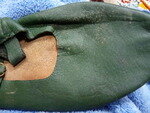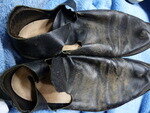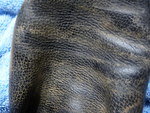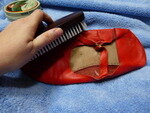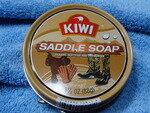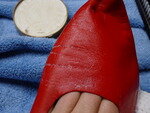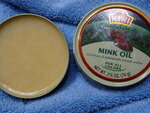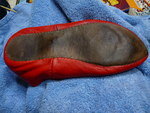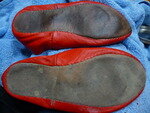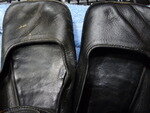The one item in my wardrobe that really takes a beating during Pennsic are my shoes. No matter what I do, eventually I'm going to have to slog through a mudpuddle, and then my shoes are wet and dirty. I sweat in them, walk all over site with them, let them dry out in my tent overnight, propr them up by the fire, and sometimes I even lose one under the carpet in my tent for a couple of days. And then I toss them i na plastic bag, seal it up, and take them home.
By the time they come out of the bag, they're really a mess. Ground in dirt, scuffs, sometimes a little mold... I make these mistakes so you don't have to.
Let's take a look at a couple of pairs of my shoes after Pennsic XLI:
Red 14th century shoes. These aren't so bad compared with some of the others.
Green 14th century shoes. I only wore these once, but it poured down rain that day.
16th century latchet shoes. I actually haven't worn these since last Pennsic, so you can see how filthy shoes get. Let's take a closeup look:
Ewww.
This year, I decided to take a more preservation-minded approach to dealing with the shoes. Here's how I cleaned them.
Note: The following method is for cleaning smooth leather only. Suede and nubuck require special cleaning methods that I will not be discussing in this guide.
What you'll need:
- Stiff brush
- Two soft cloths, one dampened
- Saddle soap
- Mink oil
- Towel to cover your surface
I started with the red 14th century shoes from the first photo above. Here's a closeup of the caked-on dirt splatters:
Take the stiff brush and clean off any caked-on dirt, paying close attention to dirt collected in seams.
Take the damp cloth and work it over the surface of the saddle soap until it lathers.
Apply the soap to the shoe and rub it well.
Don't worry if a bit of the dye comes off with the dirt, especially if the shoes are new or have never been cleaned before. This is what came off of my shoes during their first cleaning:
Remove any excess with a clean corner of the damp cloth and let dry. If you aren't planning to wear your shoes outside, you can skip the mink oil step and just buff the dry leather with a clean, soft cloth.
However, since mink oil is also a conditioner, I recommend using it once or twice a year to keep your shoes from drying out and cracking.
Load the dry soft cloth with mink oil. You don't need to scoop it onto the cloth - just rubbing the cloth over the surface should let you pick up enough to work with. Rub the mink oil into the leather until the oil no longer absorbs.
With turnshoes, I usually clean and oil the soles as well as the uppers. I try to pay special attention to any seams and spots that might be scuffed up, to make sure they will be well-sealed.
Here are the soles before and after cleaning and oiling. The top shoe is completed, qhile the bottom shoe has only had the loose dirt brushed off:
Unfortunately, red doesn't photograph terribly well on my camera, so let me show you some before and afters of the other shoes.
16th century German Kuhmaule by Bohemond Boots.
The shoe on the top/left has not been cleaned.
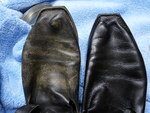 16th century latchets. The shoe o nthe left has not been cleaned.
16th century latchets. The shoe o nthe left has not been cleaned.


